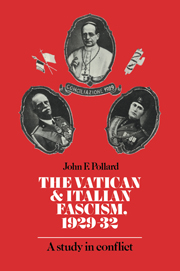Book contents
- Frontmatter
- Contents
- Acknowledgements
- Abbreviations
- 1 INTRODUCTION
- 2 THE ADVENT OF THE CONCILIAZIONE
- 3 REACTIONS TO THE CONCILIAZIONE AND THE RATIFICATION OF THE PACTS
- 4 THE DIPLOMATIC DIMENSION: ITALIAN FOREIGN POLICY AND THE VATICAN, 1929–31
- 5 THE CATHOLIC OFFENSIVE: CATHOLIC ACTION AND THE REGIME, 1929–31
- 6 THE CRISIS OF 1931
- 7 CONCLUSION AND EPILOGUE
- Appendix I The Law of Guarantees of 1871
- Appendix II The Lateran Pacts of 1929
- Appendix III The September Accords, 1931
- Appendix IV A note on archival and other sources
- Bibliography
- Index
2 - THE ADVENT OF THE CONCILIAZIONE
Published online by Cambridge University Press: 03 February 2010
- Frontmatter
- Contents
- Acknowledgements
- Abbreviations
- 1 INTRODUCTION
- 2 THE ADVENT OF THE CONCILIAZIONE
- 3 REACTIONS TO THE CONCILIAZIONE AND THE RATIFICATION OF THE PACTS
- 4 THE DIPLOMATIC DIMENSION: ITALIAN FOREIGN POLICY AND THE VATICAN, 1929–31
- 5 THE CATHOLIC OFFENSIVE: CATHOLIC ACTION AND THE REGIME, 1929–31
- 6 THE CRISIS OF 1931
- 7 CONCLUSION AND EPILOGUE
- Appendix I The Law of Guarantees of 1871
- Appendix II The Lateran Pacts of 1929
- Appendix III The September Accords, 1931
- Appendix IV A note on archival and other sources
- Bibliography
- Index
Summary
With very few exceptions, historians are now generally agreed that the Conciliazione was far from being the work of Mussolini alone, and that the origins of the Lateran Pacts of 1929 reach much further back in Italian history than his coming to power in 1922. By the end of the nineteenth century, a working relationship had been developed between Church and State in Italy, a form of uneasy ‘peaceful co-existence’, based on the Law of Papal Guarantees of 1871, despite the fact that the Vatican officially rejected that law. The emergence of a common enemy, the Italian working class movement, and the Church's reaction to the development of that movement, greatly eased the tensions between the Church and the Liberal Regime during the Giolittian Era.
The patriotic response of Italian Catholics to the First World War took that process a stage further, and by 1919 so much of the bitterness had gone out of the ‘Roman Question’ that Italy and the Holy See were able to enter into the first serious, albeit unsuccessful, negotiations for a solution of their sixty-year-old dispute. This dialogue continued under two post-war Prime Ministers, Francesco Nitti and Ivanoe Bonomi, and the progress which they made included agreement on several fundamental points that were to form the basis of the 1929 settlement.
Nevertheless, the final breakthrough was due to the boldly opportunistic policy which Mussolini adopted towards the Church from 1921 onwards.
- Type
- Chapter
- Information
- The Vatican and Italian Fascism, 1929–32A Study in Conflict, pp. 15 - 47Publisher: Cambridge University PressPrint publication year: 1985

